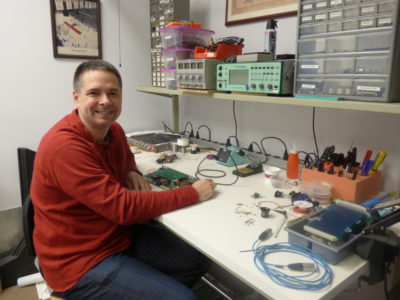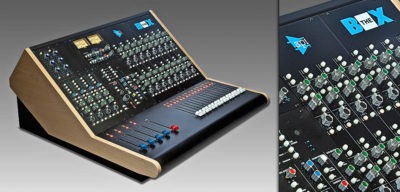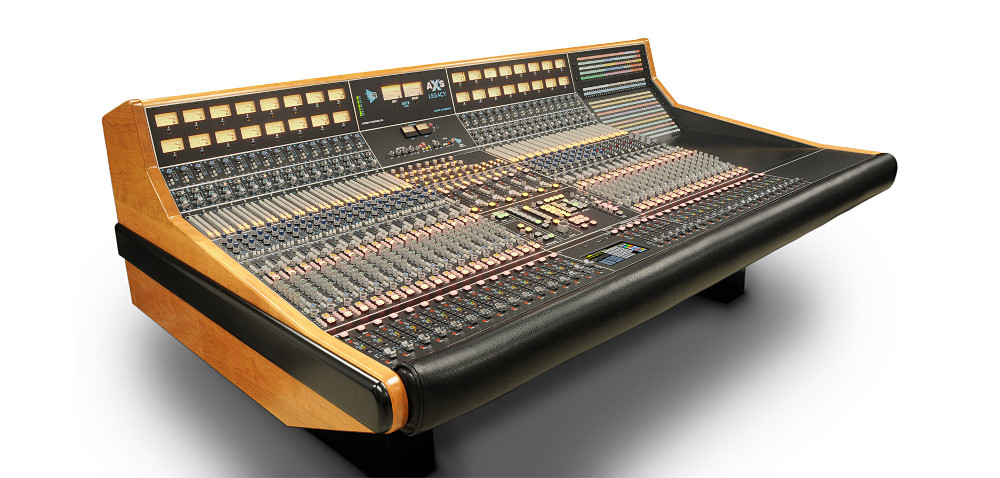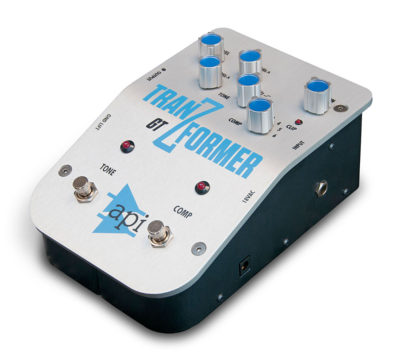Ears Behind the Gear: Todd Humora – Director of Engineering, API
Every console manufacturer has its own distinct “sound.” Ask an engineer who’s dedicated to those signature sonics, and their face will light up as they try to describe it – guaranteed.
At API, there’s a new person in charge of safeguarding that sound. Todd Humora, a 16-year veteran of the company, was recently named to the coveted position of Director of Engineering at API – a job that holds not a small amount of responsibility. After all, the design of every new API desk, 200/500 module, rackmount outboard unit, and TranZformer pedal must now pass through his hands and ears before gaining approval.
Humora heads up a tight Maryland-based team at API, one whose latest major accomplishment stands as the Legacy AXS Recording and Mixing console, which combines API’s well-known Analog Signal Path with a multitude of new features. It’s a board that sees a return to the traditional 1.5-inch module width standard, allowing for for the use of API 500-series EQs on a per-channel basis. It also has a complete center section that includes six automated stereo echo returns with motorized faders, 5.1 surround monitoring and a built-in 2500C Stereo Bus Compressor. Onboard or remote patch bay facilities are part of the design, and a DAW/Producer’s Desk is one of several customizable options available.
As you might expect, there’s more to getting one of these created than just soldering some circuit boards – engineering a new or updated API solution requires creative thinking and a whole new level of critical listening. The tricky objective: Hone a unit that will simultaneously please artists, recording/mixing engineers and his salesforce, all while maintaining a classic sound that audio pros covet.
An avowed “console junkie,” Humora talked to SonicScoop about the rewards and challenges that come with his highly desirable title.
Being the director of engineering at a large format console company is a little like being an NFL head coach: There are only so many of these jobs. What makes being Director of Engineering for API such a unique position?
As you said it’s certainly one of the few left. There’s probably fewer large format analog mixing console companies than NFL teams left out there in the world.
That’s an interesting question. I’ve never really thought about it that way just because of the way my journey got here, but we certainly are proud of the products we make and the quality of the design for them. I’m just sort of trying to maintain that, and maintain the history and keep the flow of designs and products and production together. That didn’t really answer the question though, did it?
Said like a true engineer! That’s your technical mission. I’m imagining you and your counterparts at SSL, AMS Neve, Harrison — what is it that your small group has an opportunity and a responsibility to do?
I certainly feel a responsibility — and I would think that any of those positions would feel the responsibility — to maintain the high-quality products. We have a world where it’s great what you can get and put in your basement or your little home studio now and be able to do, but we certainly want to maintain that highest quality of audio period, from input to output. Certainly for me at API, that means also a lot to maintain the quality and the history that the company has.
An Early Start
You’ve been with API for 16 years now. How did you come to join the company initially, and what are the various titles you’ve held since you’ve joined?
This is the fun little story I like to tell. I actually started working for [API President and Owner] Larry Droppa as my first job out of college back in 1996. At that time I was designing live consoles for Audio Toys, the Paragon II and other such things like that, the live consoles. That’s the angle I came in at. Larry bought API, I think it’s ’99, right around there somewhere.
I started basically as an engineer. Another gentleman was the head engineer at the time named Shane Morris. He and I worked together as basically the two engineers for Audio Toys for a number of years. After API had come online Jeff Bork and Paul Wolff and Shane, the four of us merged together for a while sharing tasks and chores, and then my wife and I moved away for a while in 2002.
So pretty much when I started back again in 2006 API product was what was left and I worked under Jeff Bork, who was the Director of Engineering at the time. I returned just as another one of the engineers in the department, continuing to design products and refresh products, or design new products and redo some of the older products as need be over the years.
In January or February of this year, Jeffrey Bork moved out West with his wife. He jokingly said his wife had moved for him many times in their lives and she got a job opportunity this time, that it was his turn to follow her, so he left the company as a full-time in-house engineer, but he still works for the company on a remote freelance engineering basis. There was a period to see how things went with me as Director of Engineering and things went well, so they offered me the position full-time.
Engineering for an Evolving Audio Landscape
How have you seen the needs of audio engineers and studios change over your tenure at the company?
Certainly when I started 20 years ago, the digital console wasn’t really a reality yet. People were just sort of tinkering with the ideas. There was some digitally controlled of analog stuff out there, like the Soundcraft Broadway I think was one of the first ones way back when. While I was still doing the live stuff is when Yamaha’s 02R and then the big PM1D came out. Certainly for a while digital had taken hold and we maintained the analog philosophy. API, as you I’m sure know, we have one digital product, which is the A2D mic preamp with the digital output.
The other major change is, obviously it doesn’t take rocket science to see the large format studios becoming fewer and fewer far between, when API obviously is going to start selling fewer and fewer large format consoles. The company’s been evolving. The 1608 [16-channel console] came out eight years ago maybe? Certainly not more than 10, because we were developing it right as I started back in 2006, and it probably took us a little while. That’s what we would call a mid-range console, which is something that API hadn’t offered in many many years. It was either a big guy or just individual rack pieces.
More recently, we’ve got even smaller with THE BOX [small format] consoles. Again, just seeing that market evolve into more of what you can do in your home. We try to provide the analog pieces to perhaps round out some of those home studios a little bit more warmly, depending on what somebody wants, whether it’s mic pre’s or mix summing or things like that.
When we’re talking about a console like THE BOX, it’s got a smaller footprint. What are the other aspects of a board like that? That the engineering team huddles together and thinks about to say “Okay, this is going to be more optimized for the project recording and mixing market.”
The best current example of that is the new AXS console. At first glance until you get into it deeply, it just sort of looks like a redone Legacy Plus, but we certainly tweaked a lot of functions and features for what we think the modern mixing situation looks like.
Probably the biggest aspect or the biggest new feature there is the new return module which we designed, which was a lot of just sitting around and talking around collaboration with our sales guys, sales and marketing, as well as the service guys going, “What does this actually need to look like in that set?”
What we came up with is that stereo return module. The big buzz words these days are things like parallel compression and functions of that nature, and that module gives you a stereo automated insert, automated fader, with bus feed to allow you to do those sorts of parallel compression and those sorts of really creative artistic mixing, which has become more of a creative piece of crafting a mix these days. That’s just one example.
Can you take us inside the workbench for the creation of something like the return module? What’s the workflow for developing and perfecting it?
A big piece of the development is literally just the control surface. I have dozens of versions of the console as a whole layout, including those modules. I would come up with a layout and we’d print it out in our plotter one-to-one. something I do is I try to develop a block diagram in parallel with it. Just because you see a button and although everybody know what the button does, you look at the block diagram and see how it flows.
The sales guys, they only see the top surface, so at the same time as I’m doing the top surface, there’s going to be some layers underneath just to make sure all of my components fit to the front panel, you know what I mean? I can’t put switches too close together, I can’t put a fader too close to something else, just because they physically wouldn’t fit.
The return module is a bit of a compromise. I had to take that home one weekend when we finally figured out what we wanted it to do. The sales guys were like “Oooh, we’ve never had an automated full-length fader. That would really be awesome.” And I’m like, “It just doesn’t fit.” I took it home one weekend and I’m like, “All right, how can I make it fit?” Again, that’s just 2D at that point, just a top view, but it has the outlines of all the components underneath, and then a just amount of trying to figure out, “Well if I do this and do this and do this, can we make it fit?”
Once we have a control surface that performs the functions that we want it to perform and flows intuitively and makes sense, then engineering starts to go board by board and do layouts and at the same time, we were building our frame in 3D just to begin the frame structure. As we would do each module, we’d go from that 2D to the 3D with our newer software and make sure that the whole printed circuit board assembly – and often most modules are multiple boards — make sure that they all fit together and the hardware’s the right height.
Is that process pure fun for you, or is there also frustration and challenges mixed in with all that? You made it sound pretty seamless.
There are definitely challenges, but that part, that creative part is usually the most fun. I could sit locked away in an office and lay out printed circuit boards all day, it’s just a fun puzzle. How do you make it all fit and make it look good? As I was once told, you sort of see the audio flow down the board and you make it as smooth as possible.
The API Sound Defined
Through all this, you have to maintain the API sound, correct? How would you characterize that sound and where does that come into play?
It certainly comes into play in maintaining the classic API circuitry which most of your readers would know is the 2520 [op amp] and the transformer on the output side and just maintaining that discreet design and output transformer as well as all the input stages, using the 2510 op-amps.
Then of course, with the mic preamps, the same circuit that’s been that way forever with the mic pre transformer and the 2520 and the output transformer, that’s certainly all the same and unchanged in the EQ sections, which we’re also known for. Those circuits are unchanged in this console as well. This console actually goes back to the 500 module, so it’s a straight 500 module drop-in of any of our 500 EQs. We always maintain those core blocks.
I just asked you about what makes for that classic sound, but I’m also interested in the exciting new tools and technologies that are available to you and your engineering team now, that will allow you to improve on current audio products and make new audio solutions as well.
I alluded to one of them. In the last couple years we’ve gotten heavily into the 3D stuff. We still have some printed circuit boards that are in old DOS, PCB, layout stuff. Certainly, especially that new AXS console was designed completely in our newest software and every piece of it was checked in 3D and it certainly helped speed up our design to finished product time. We designed that console in under a year from original conception to prototype to now taking orders and going into production.
500’s And Pedals
You had mentioned the 500 and that’s my next question. API is also known for pioneering the 500 format, which is ubiquitous throughout the studio world. What’s your take on why 500 series gear has proven to be so popular, and how is API continuing to evolve that format?
It certainly gives a really easy way for anybody to build a little module. You don’t have to deal with a power supply, the I/O, all that infrastructure is there, you just need a plugin card. It jump starts anybody who has an idea and wants to just try it. It doesn’t obviously finish but it gets you going. It means you get to design a lot less.
I think the users like the ability to mix and match to their hearts’ content. I’ve seen some pretty crazy pictures of 1608 consoles and stuff, it’s just a rainbow of different modules. We’d obviously like them all to be API, but we get it that there are other sounds out there that some people just have to have.
We’ve had a few new ones ourselves that we’ve come up with the last few years. We did a filter module, we’ve also done some redos — we did the redo to the mic preamp to add the variable output of the modules. With the 1608 and THE BOX and now with the AXS console going back to the 1.5-inch width, revitalizing it in the console side of things. With the Legacy Plus and Vision, it being 1.25 inches, the only place you could put 500’s is if you opted for options buckets to have 500 slots in them. Now it’s every channel.
I also wanted to ask you also about the new TranZformer GT Guitar and LX Bass pedals. Did you have a hand in their creation?
Not really, no. That was Jeff Bork who did a lot of the early design on that, and then Jeff Richards, one of the other engineers, he was the one who did the finish work on it. I certainly was on the periphery and would be in discussions. When we went to do final checks on things, I would be around to look and listen and compare and contrast, but the layouts weren’t my baby.
I understand you said you were kind of on the periphery for it, but I know when I was at AES I saw it and I was very surprised by it, I think a lot of people shared that sentiment. What does a product like that open up the door for you and your team to create in the future? Can we expect other type of unexpected products in that vein to maybe start coming from API?
Certainly, possibly. We’re always keeping an eye out for some place to grow into a market that maybe we weren’t in before. I sat in on some people who have tested out that pedal and just to watch some guitar players play with it — just the sounds that they are able to create and get that warmth with the transformer and everything through there is pretty exciting , hence the name.
A guitar player wouldn’t necessarily think that API gear would be for them and now they can think that. We’ll certainly always keep an eye out in different places where we think we can provide a good product for people.
Listening at Another Level
What do you think you listen for as an engineer at API that may be different in the way that other people are listening. Are you like a professional taster in the culinary world? What’s different about what you’re listening for and how you listen?
Interesting question — I’m going to contradict myself here immediately: We want to keep things as clean as possible, but then the API sound is the contradiction to that. Not that it’s not clean, but it’s its own character. We definitely scrutinize very deeply that we don’t add any offensive artifacts. Clicks and pops and buzzes and noises of any kind from switching and things like that. They need to just be not there at all. It’s not a little bit tolerated.
As far as you said the API sound, we create a clean canvas and then we put the API characteristics on it. At the end of the day, we listen to everything and make sure that it meets what we expect for an API product.
If you’re designing something and you do hear those clicks and pops, something unexpected, where do you have to look to try and route those out?
At the circuit level, it’s just something’s not right as far as for a click and a pop and a switch, a decoupling situation, there’s going to be DC somewhere. You gotta go right down to the circuit level, find out what stage it’s coming from and correct the circuit.
A Console Junkie
Are there other companies out there, either in hardware or software, that you think have done a good job creating products that the pro audio world is responsive to? Who’s doing work that you personally admire?
I certainly have always been, dare I say, a console junkie. I like a beautiful mixing console. I come to the pro audio world through the live side of things, but that stands for both the recording and the live.
I always liked Cadac consoles, I always thought they were quite pretty. The British company — forever they had the theater world. You see a Cadac J-type and it’s a big thing. I say that and I made a Paragon console which is also a big thing! I think some of their new digital consoles as they’ve evolved have been quite pretty as well. I always like to check out different consoles, just to see how people have done that control interface.

Not as big as a console, but 500 modules like this 550b Discrete 4 Band EQ are a hallmark of API’s influence.
Why do you think you’re a console junkie? Why does the large format console still remain something that stirs such passion for audio engineers?
It’s just a massive thing and relative to a 500 module, it’s just big. When they’re conceived and designed well, they’re very flexible and functional and can do a whole lot of stuff. And with a large format console you get to see the whole mix in front of you. You just feel more “in it.”
What makes engineering for the audio world a particularly compelling venue for an engineer — as opposed to cars or HVAC systems or anything like that?
Cars would be fun too! Only in the sense that I have a bit of an affinity for Formula 1, which is quite an engineering feat in the car world.
I’ve always grown up liking audio and music and sound and those sorts of things. It’s just been a natural evolution for me. It’s something I like. At the end of the day, I’m making something that I would like to use.
Last question: If you could be present for API gear being used to record any artist, living or dead, who would that be, and where would the session take place?
To answer the second part of your question, it would be any studio with an AXS console because that’s my newest baby and I’d love to see it in action.
The first part of your question — musicians. It’ll sound corny, but I’m a piano player so I have a love for piano musicians which over the years have included Billy Joel, Elton John, Sara Bareilles, also some jazz, like Ellis Marsalis, Jr. Just a simple piano and/or small little band is something I always liked to listen to.
You get a great piano to begin with, a nice big old grand. It’s spectacular on its own, and then you give it some API warmth — I could listen to that all day long.
- David Weiss
Please note: When you buy products through links on this page, we may earn an affiliate commission.










